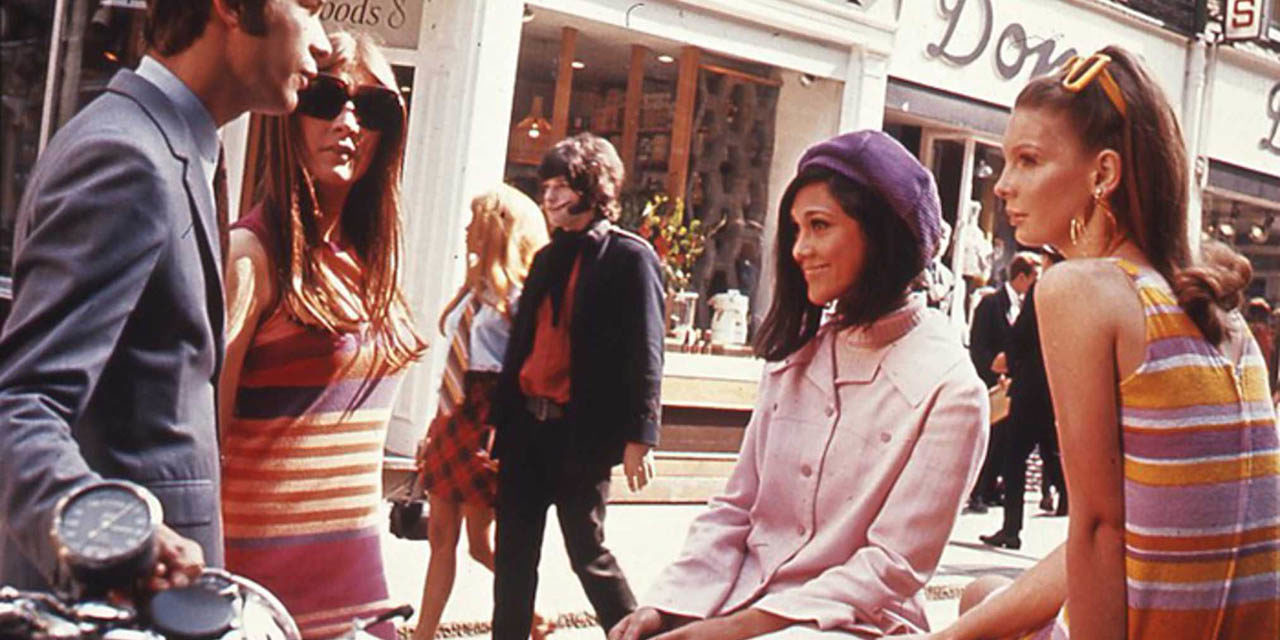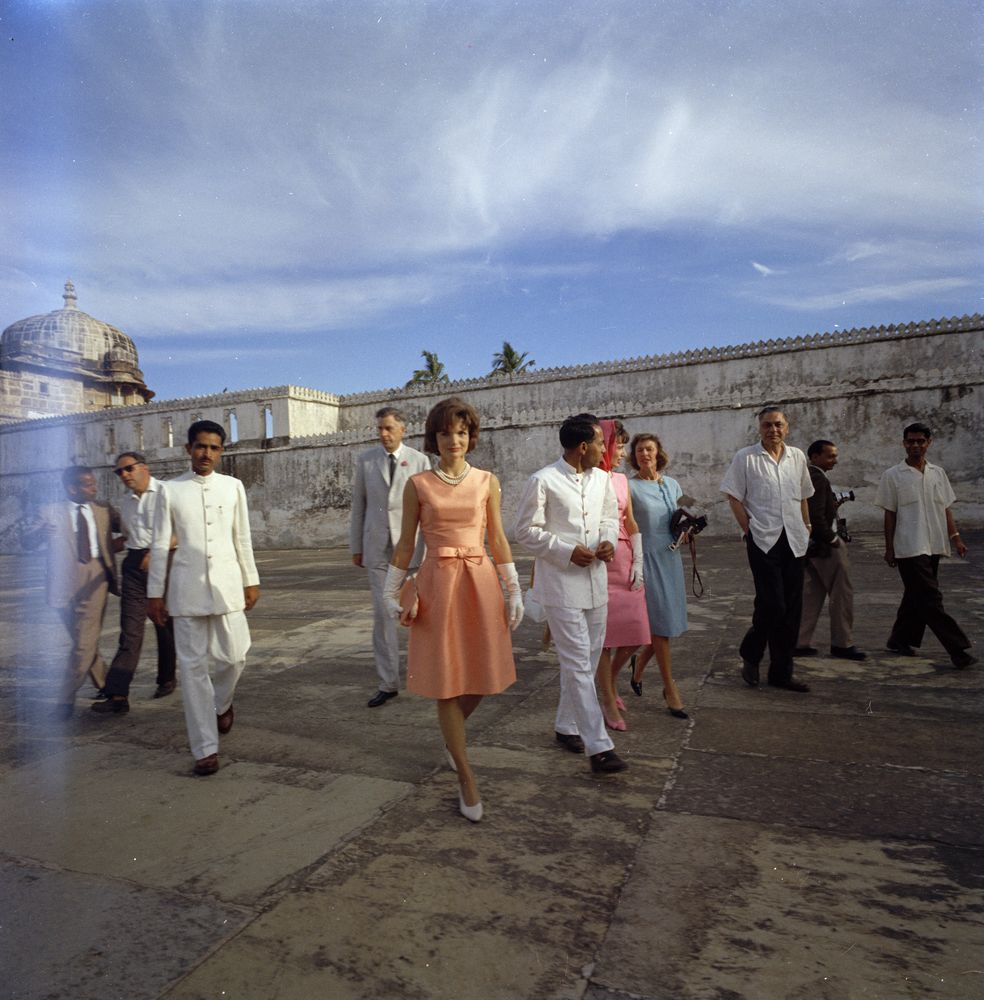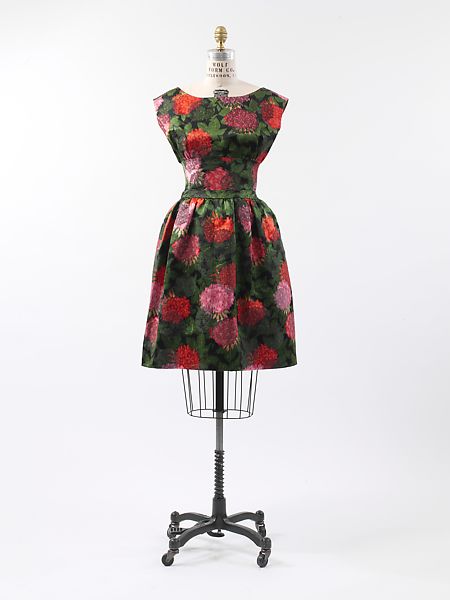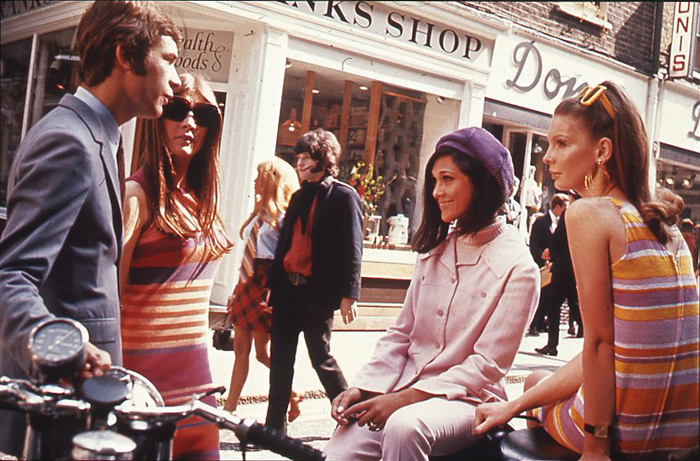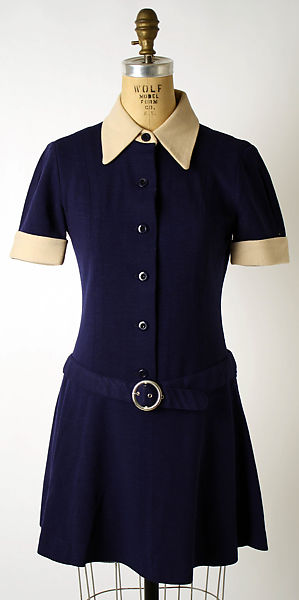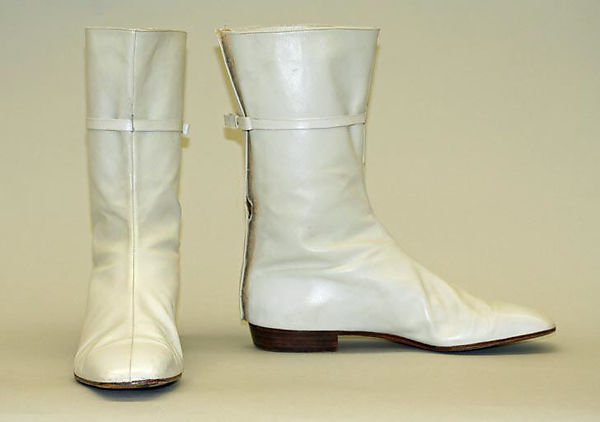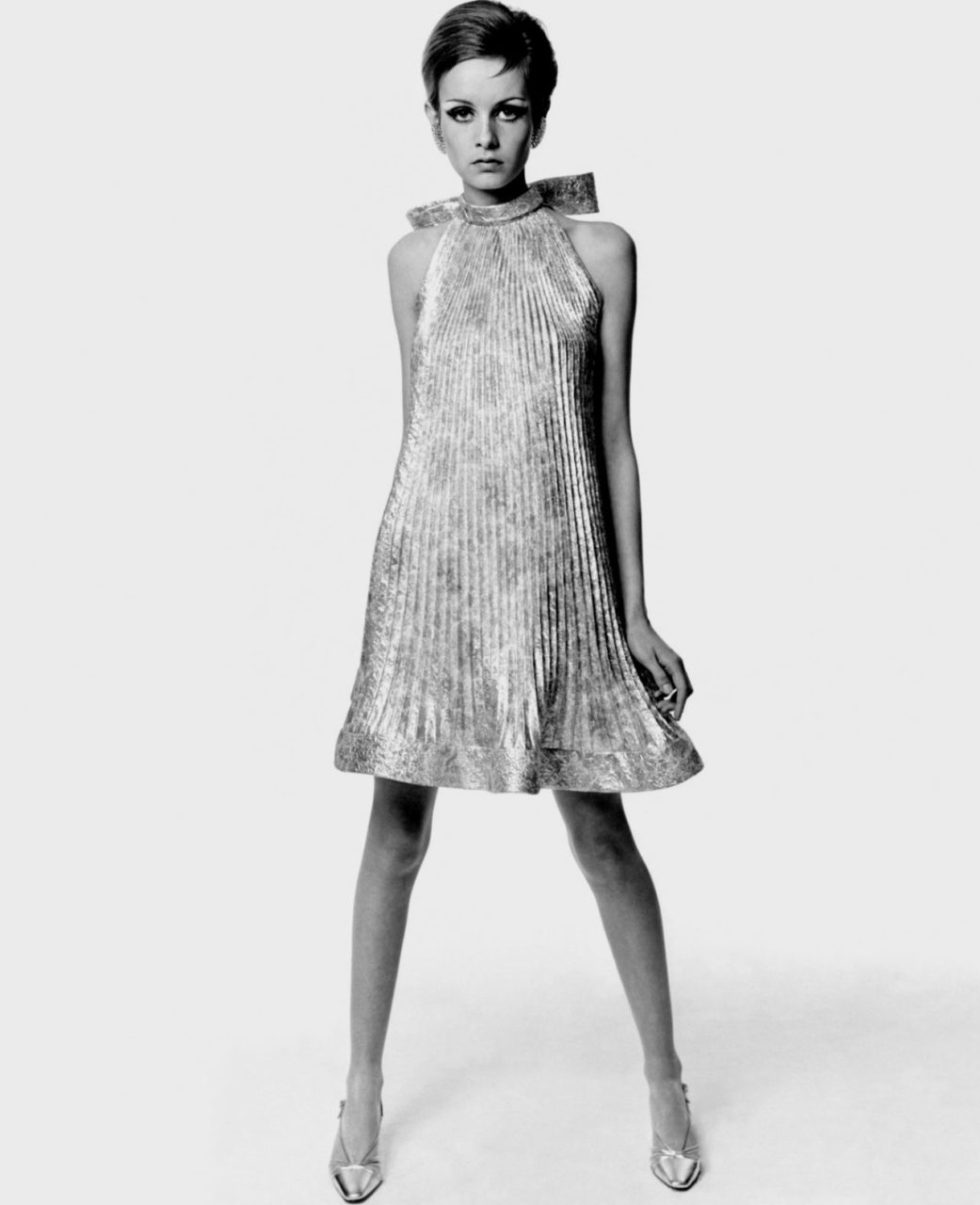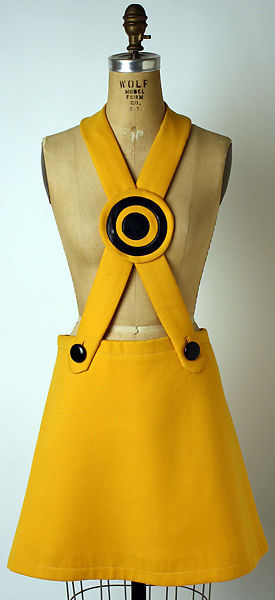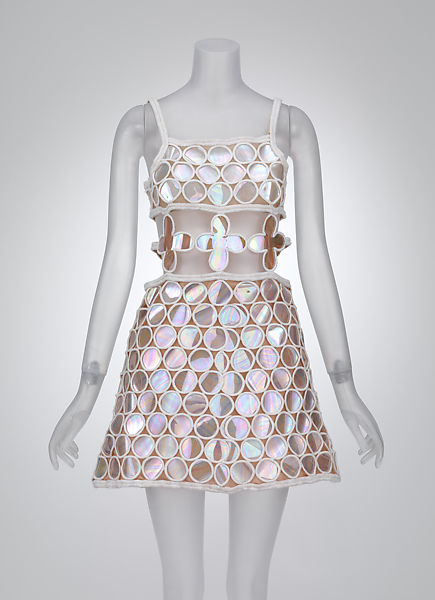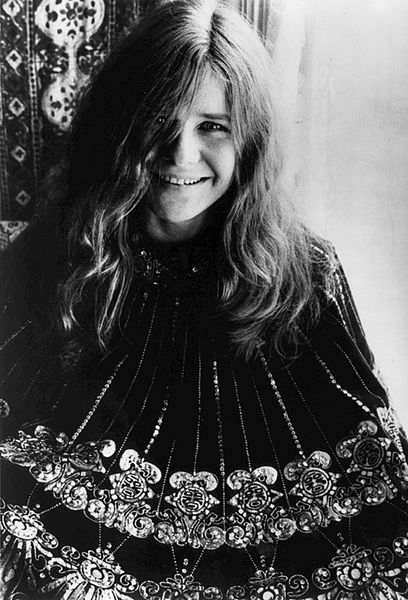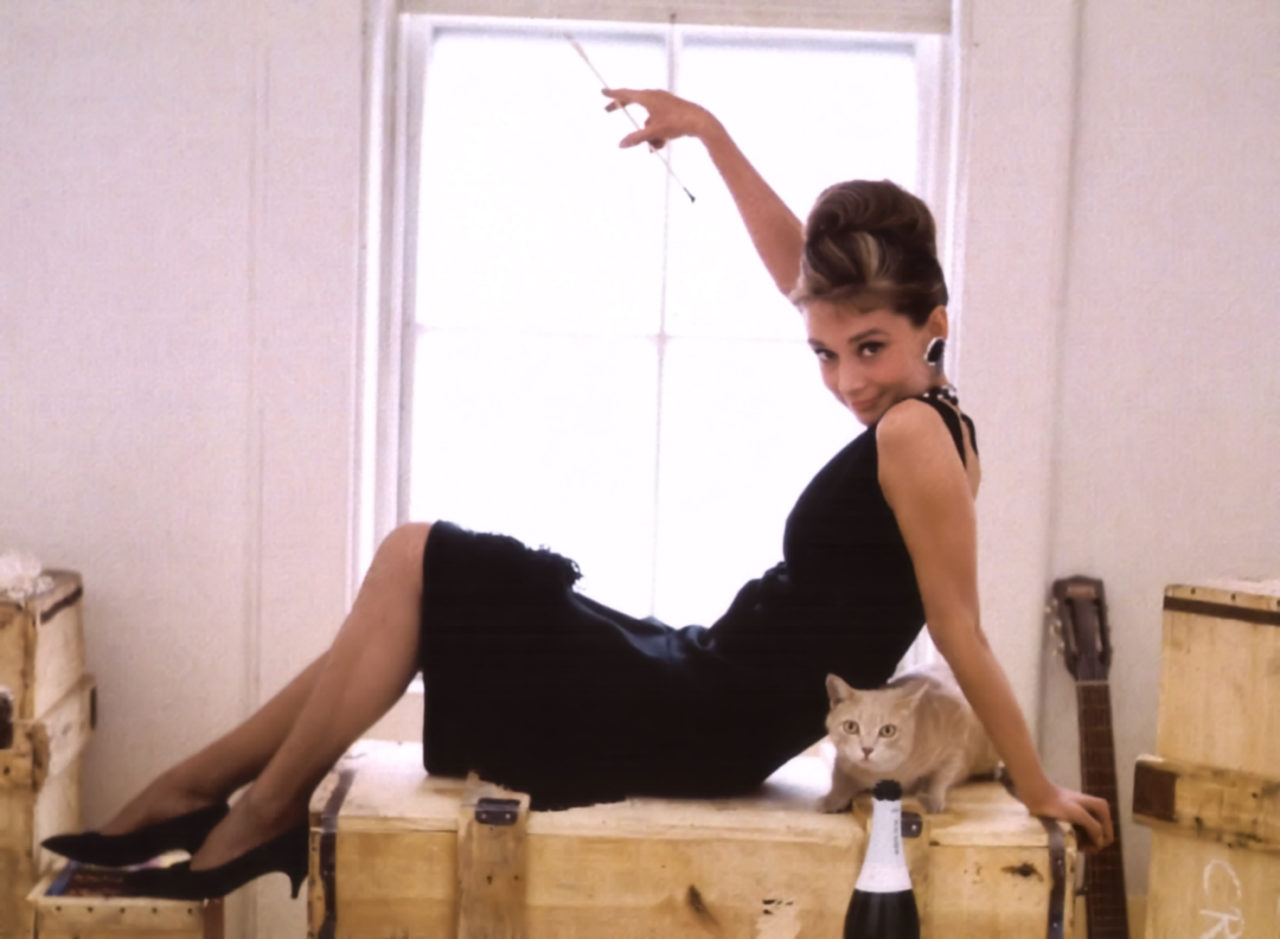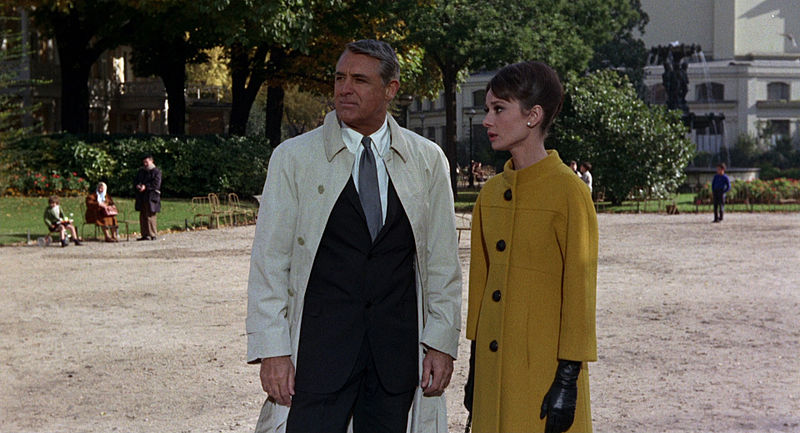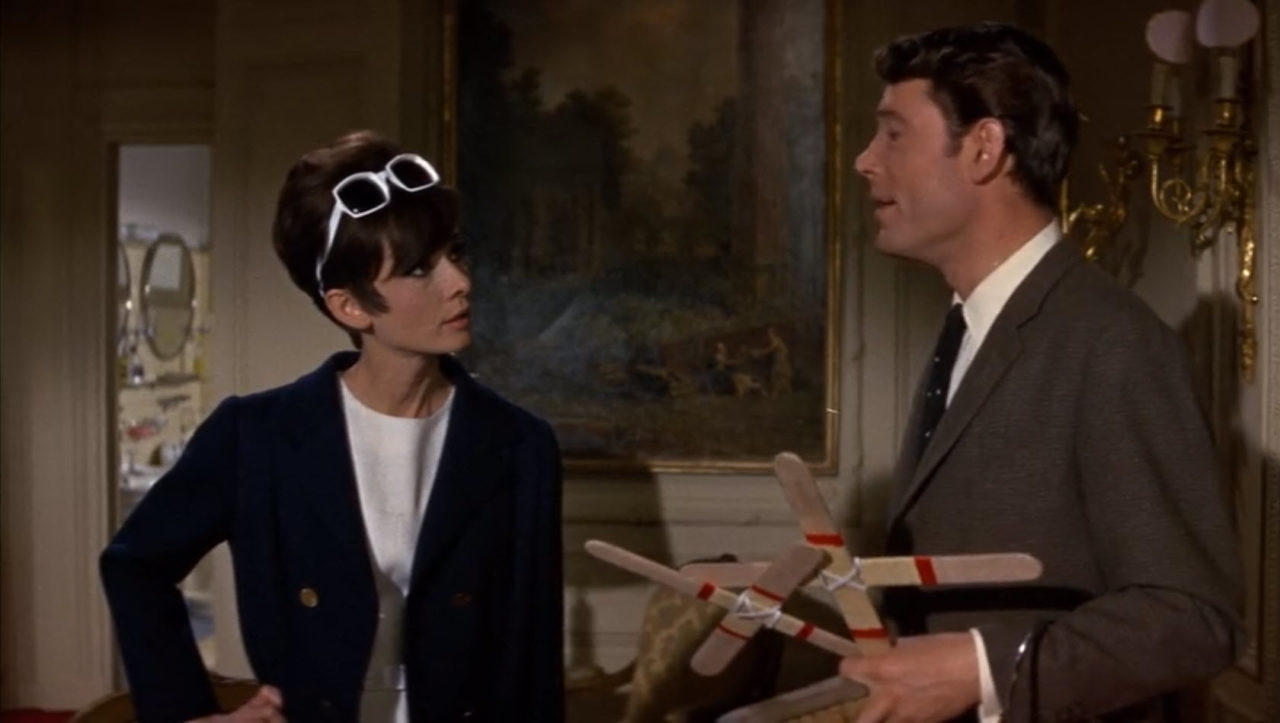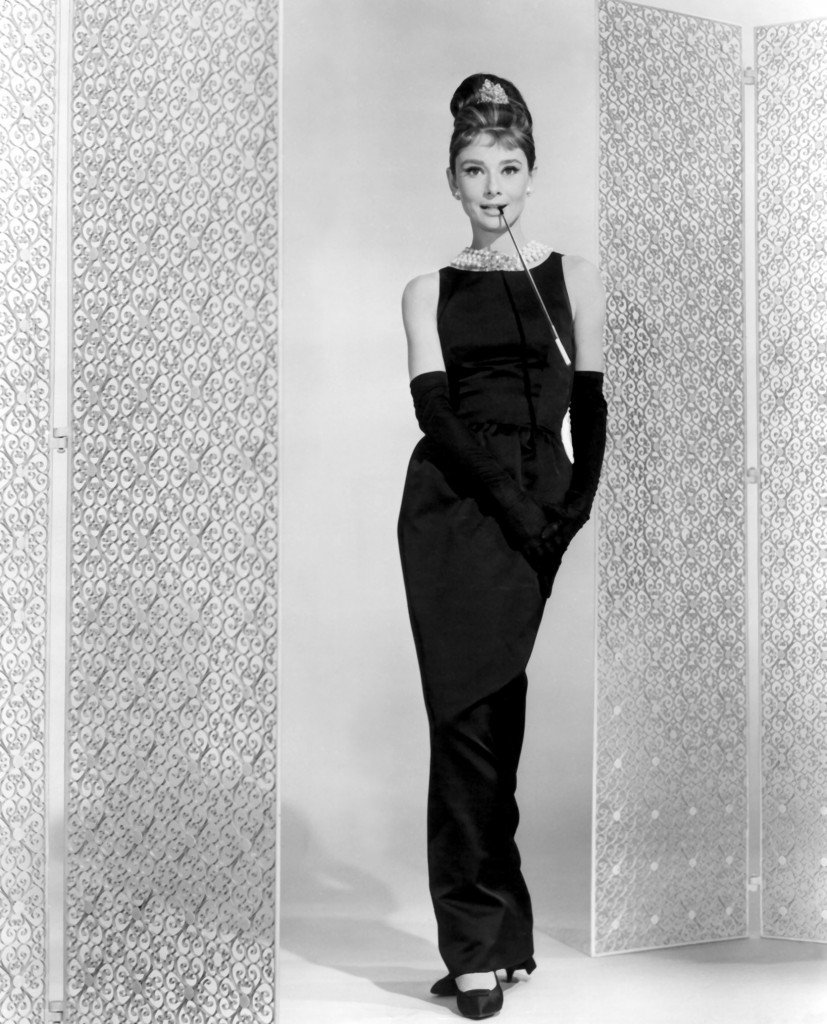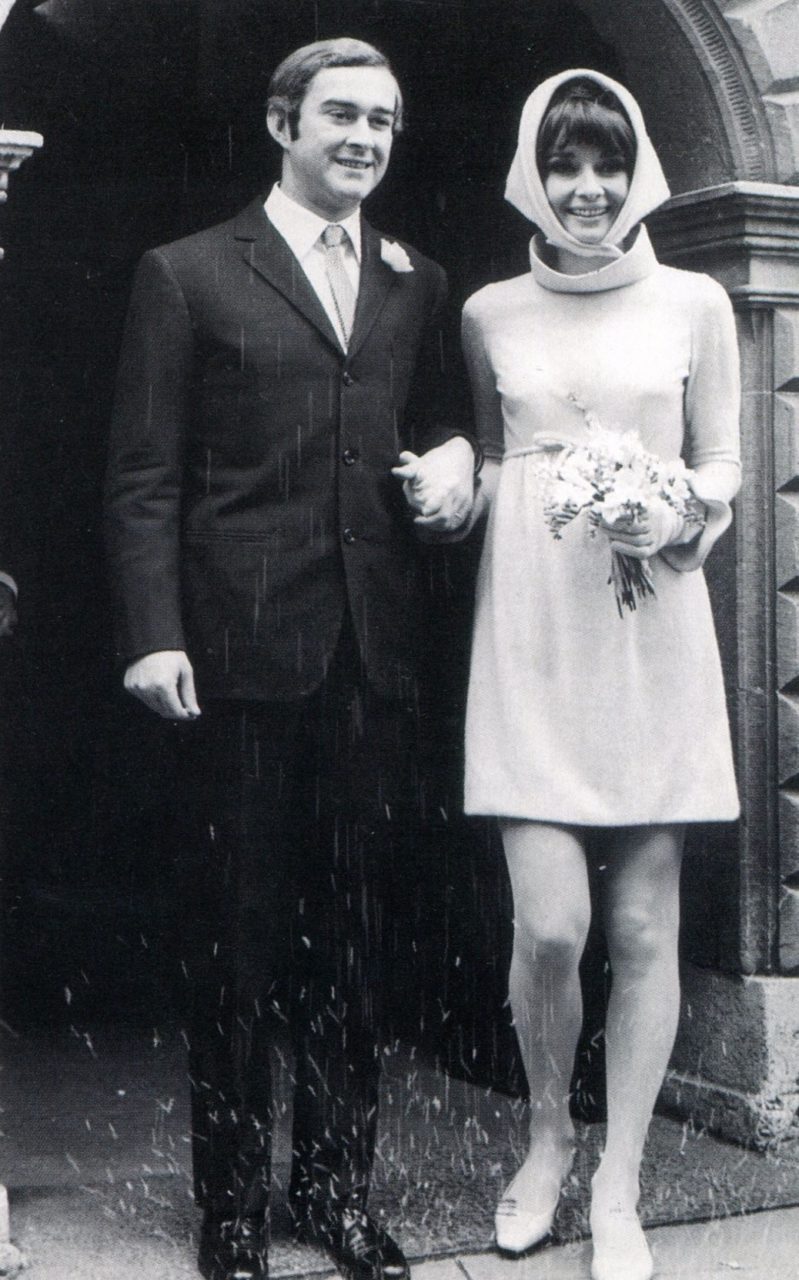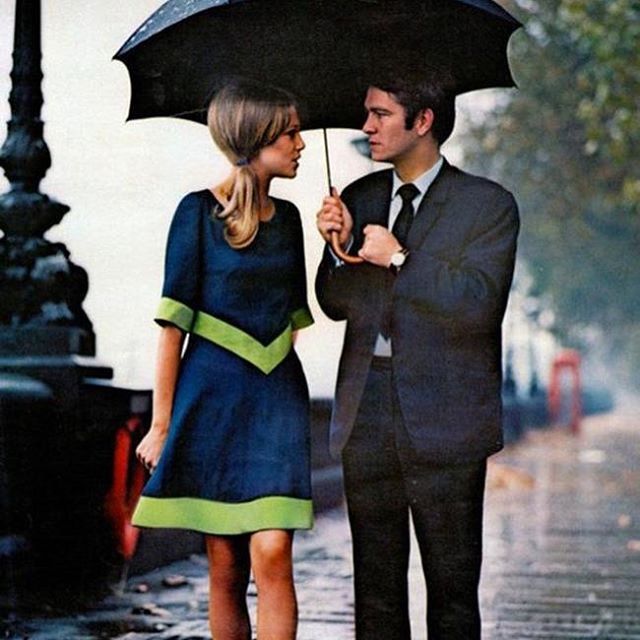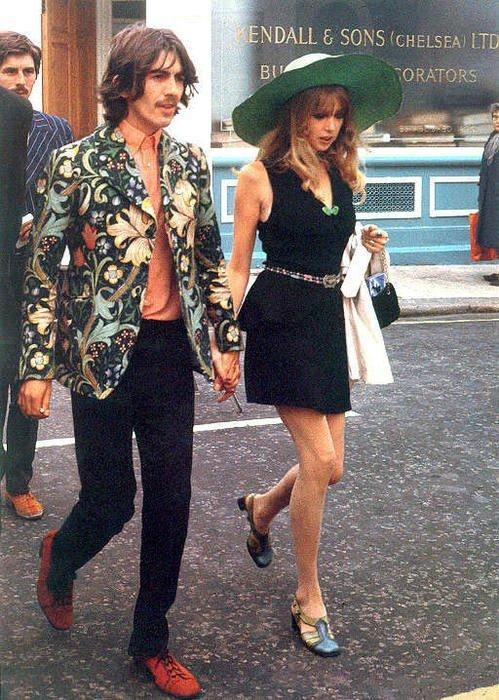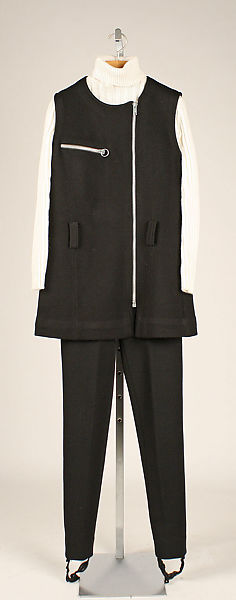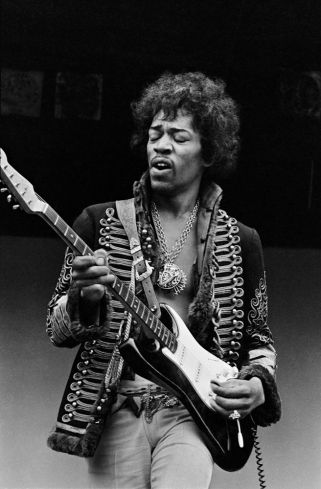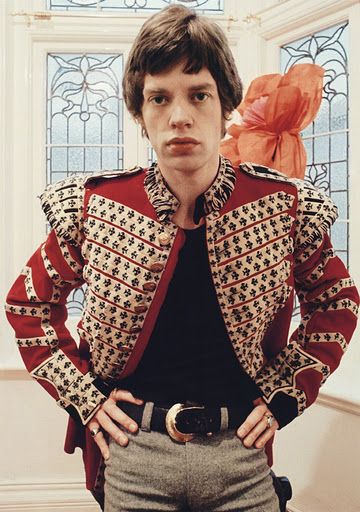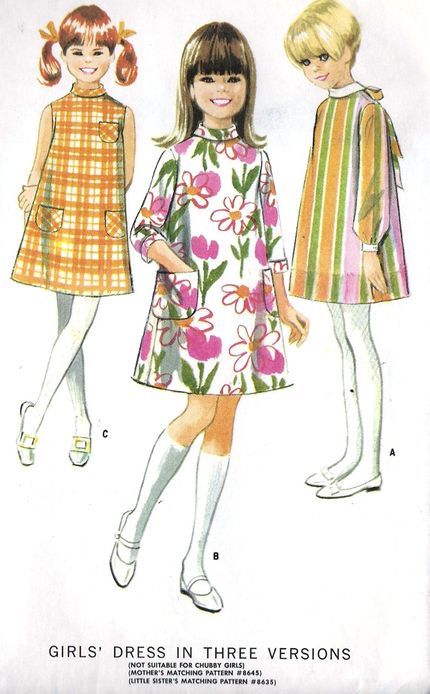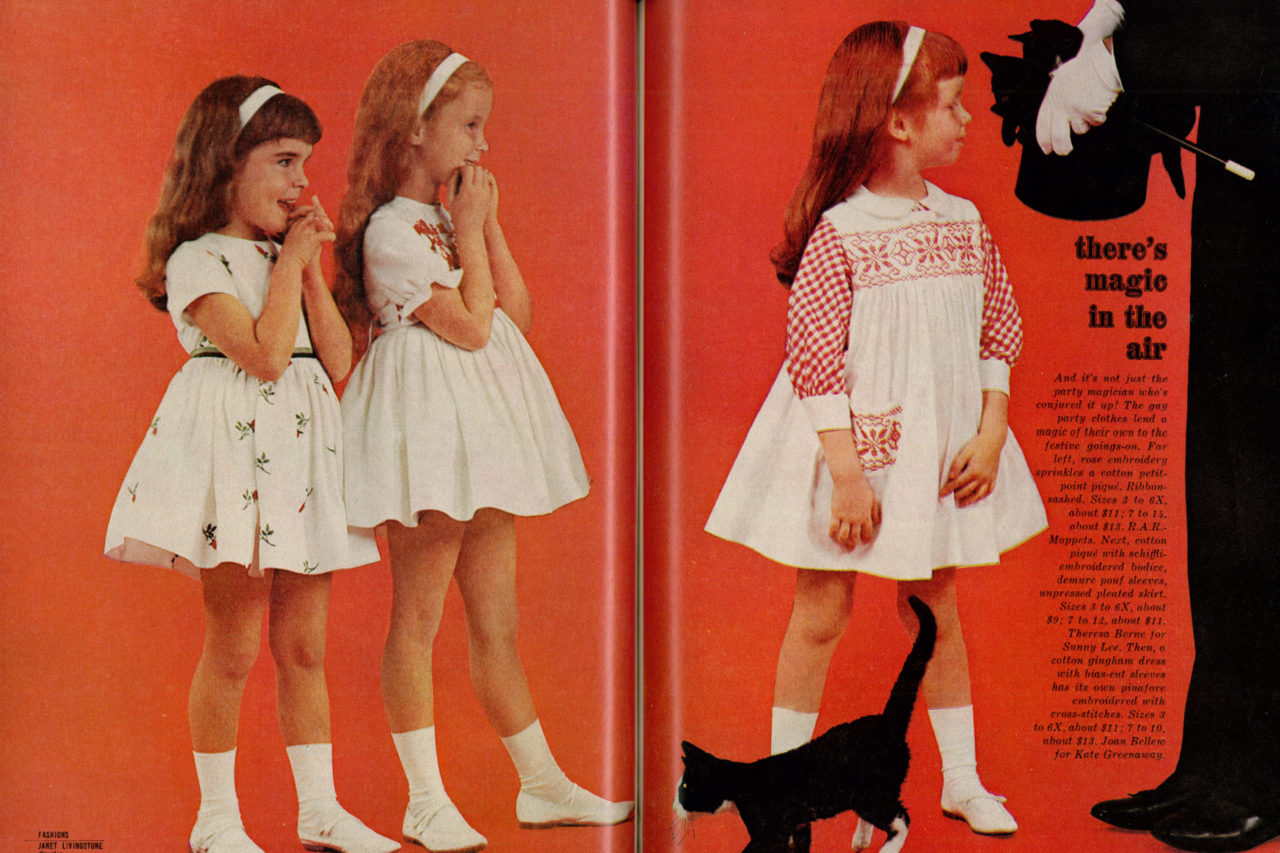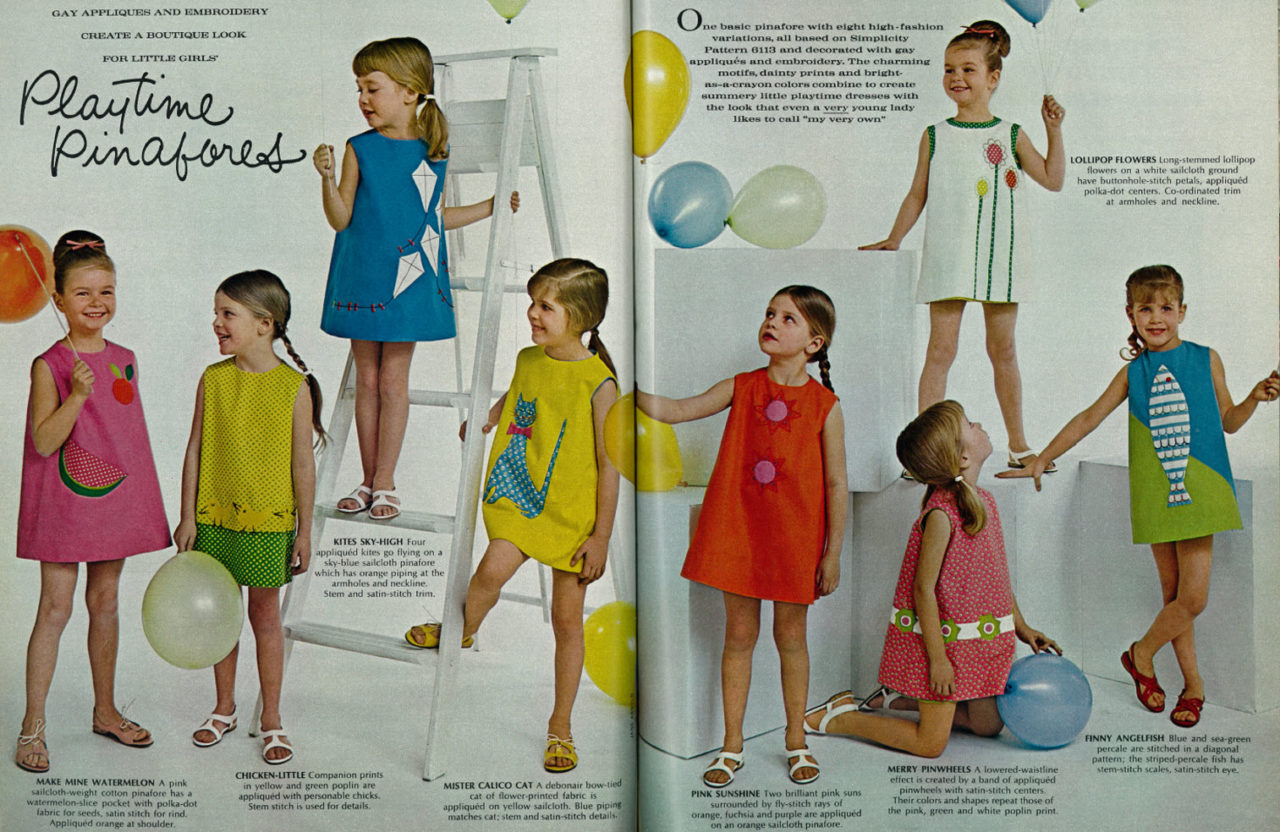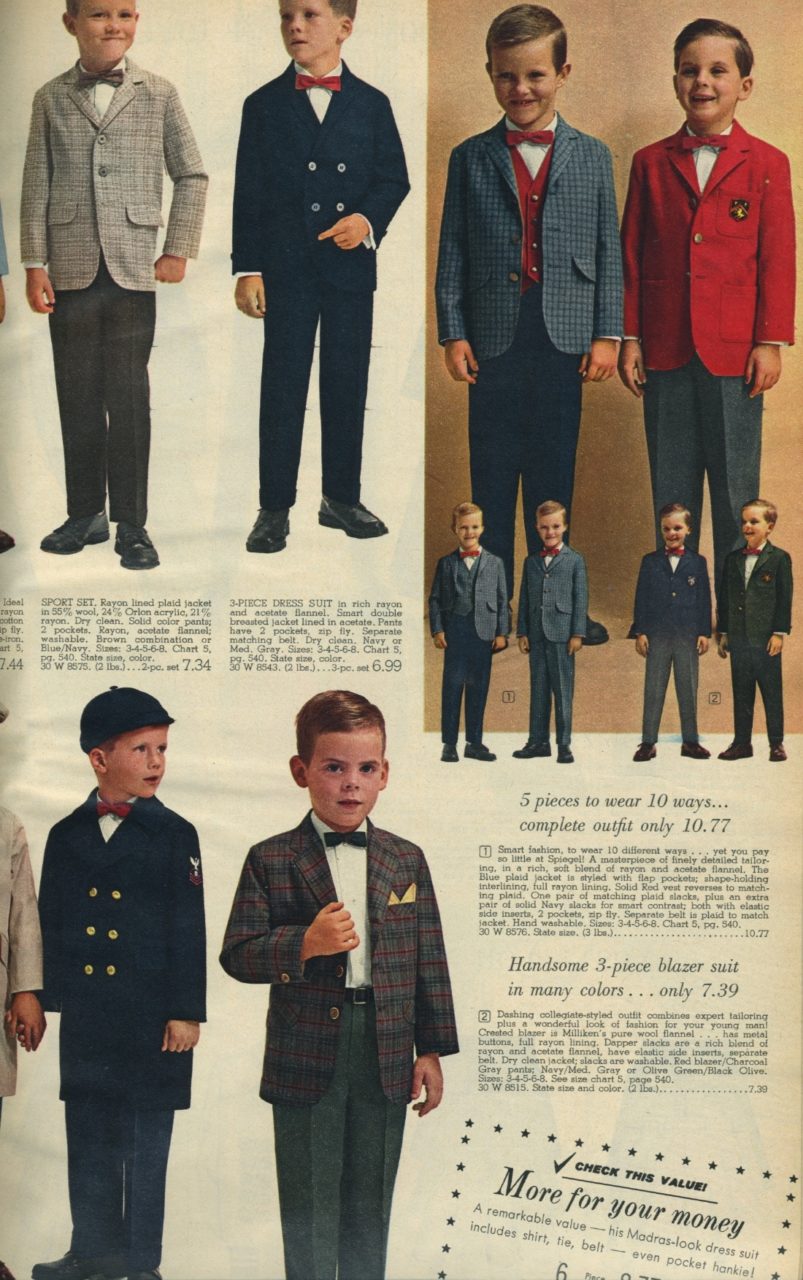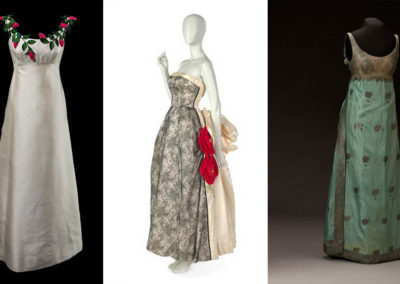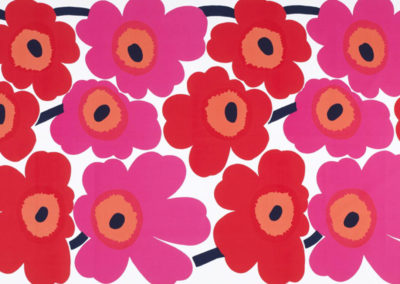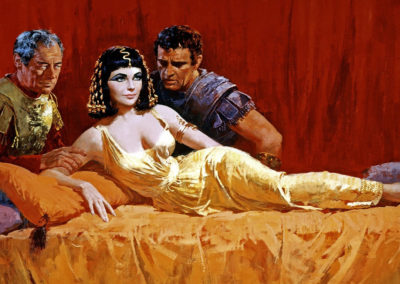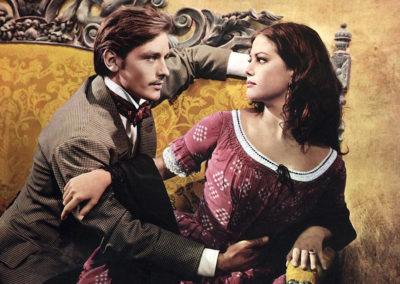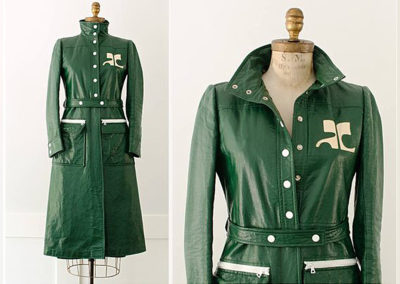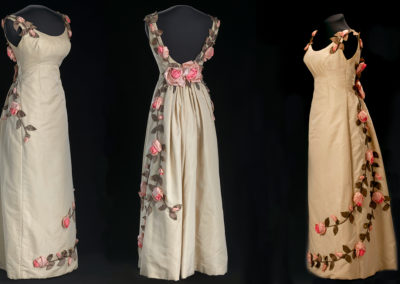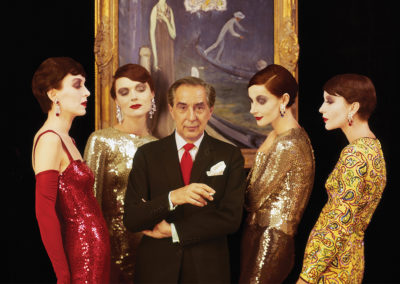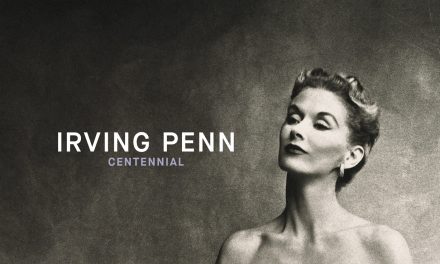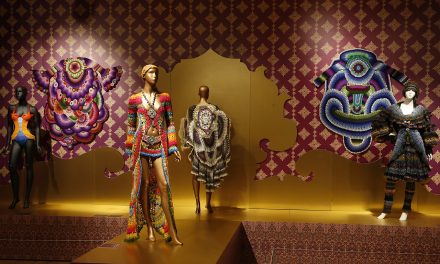OVERVIEW
Fashion in the 1960s became progressively more casual across all genders and ages. Womenswear followed three broad trends: a continuation of the previous decade’s ladylike elegance, the youthful styles of Mary Quant and the Space Age influence, and the late 1960s “hippie” style. Menswear saw an increasing amount of color and pattern, military influence, and new fashion icons in the form of rock stars. Children’s wear saw less change, but also became more casual and bright in color and pattern.
Womenswear
In the early years of the decade, fashion continued along the lines of the 1950s. Skirt suits and coordinating accessories were emphasized as one decade transitioned into the next. First Lady Jacqueline Kennedy epitomized this look during her husband’s presidential campaign and short presidency. She was admired around the world for her put-together, lady-like look consisting of boxy skirt-suits like the Givenchy suit in figure 1 and navy suit in figure 2, sheath and A-line dresses (Fig. 3), and luxurious coats–all accessorized with white gloves, pearls, and a matching hat. This look was being produced by the likes of Hubert de Givenchy and Cristóbal Balenciaga (Fig. 4), but as the decade progressed, it became clear that the momentum was towards a new kind of designer in the 1960s.
Fig. 1 - Hubert de Givenchy (French, 1927–2018). Suit, 1960. Wool. New York: Brooklyn Museum Costume Collection at The Metropolitan Museum of Ar, 2009.300.453a, b. Gift of the Brooklyn Museum, 2009; Gift of Lauren Bacall, 1967. Source: The Metropolitan Museum of Art
Fig. 2 - Robert Knudsen (American, 1929-1989). President John F. Kennedy and First Lady Jacqueline Kennedy attend Mass at St. Mary’s Church, Newport, Rhode Island., October 8, 1961. Negative; (2.25 x 2.25 in). Boston: White House Photographs. John F. Kennedy Presidential Library and Museum, KN-C19037. Robert Knudsen. White House Photographs. John F. Kennedy Presidential Library and Museum, Boston. Source: John F. Kennedy Presidential Library and Museum
Fig. 3 - Cecil Stoughton (American, 1920-2008). First Lady Jacqueline Kennedy tours the island palace of Jag Mandir (also called the “Lake Garden Palace”) on Lake Pichola, during her visit to Udaipur, Rajasthan, India., March 17, 1962. Negative; (2.25 x 2.25 in). Boston: White House Photographs. John F. Kennedy Presidential Library and Museum, ST-C117-20-62. Cecil Stoughton. White House Photographs. John F. Kennedy Presidential Library and Museum, Boston. Source: John F. Kennedy Presidential Library and Museum
Fig. 4 - Cristobal Balenciaga (Spanish, 1895–1972). Cocktail dress, 1962. Silk. New York: The Metropolitan Museum of Art, 1994.147.3. Gift of Rosamond Bernier, 1994. Source: The Metropolitan Museum of Art
Fig. 5 - Photographer unknown. Swinging London. Teenagers in London's Carnaby Street., 1969. The National Archives UK. INF 14/147. Source: Flickr
Fig. 6 - Mary Quant (British, Ca. 1934-). Ensemble, ca. 1968. Wool, acetate. New York: The Metropolitan Museum of Art, 1989.336a–c. Gift of Paula A. Heidelman, 1989. Source: The Metropolitan Museum of Art
The cultural phenomenon termed Swinging London began in 1955 but reached its zenith in the early- to mid-1960s. It was a phenomenon that focused on youth, spotlighting music and fashion. It brought us The Beatles and the miniskirt, Twiggy (Fig. 9) and The Who. The designer who led the way in the “youthquake” was Mary Quant who opened her first shop, Bazaar, on the King’s Road in Chelsea, London in 1955. Quant’s simple, colorful designs appealed to teenagers and young people who had more disposable income than any generation before. It differed from the stuffy looks of the older generation and appealed to young women who embraced the child-like styles Quant produced (Fig. 7). Fashion historian James Laver writes of Quant in Costume and Fashion: A Concise History,
“Rejecting the constraints of seasonal shows, she produced as many as twenty-eight collections during her early years, creating simple, practical, often mix n’match designs which had an element of classlessness perfectly suited to the mood of the sixties” (261-262).
Bazaar was in the new boutique style, a revolutionary new way to shop that differed from the traditional designer atelier and the department store. Besides the accessibility of the clothes in the shop, boutiques also created a frenetic atmosphere, as seen in figure 5. In her book The Lost Art of Dress, Linda Przybyszewski writes, “Boutiques were groovy places where modern music played and young owners and customers collaborated on new looks that came only in small sizes” (202).
One of the most revolutionary designs attributed to Quant was the miniskirt and minidress (Fig. 6). Eschewing the prim below-the-knee skirts of the late 1950s and early 1960s, by the mid-sixties, young women were wearing skirts that fell at the upper thigh. Like the short skirts of the 1920s, the miniskirt shocked but was also a highly popular look for young women. Miniskirts and minidresses were adopted by Parisian designers as Quant and her contemporaries continued to gain popularity.
Fig. 7 - Unknown. Jean Shrimpton and Celia are wearing Mary Quant designs, ca. 1960s. Kristine. Source: Flickr
Fig. 8 - André Courrèges (French, 1923–2016). Boots, 1967-69. Leather. New York: The Metropolitan Museum of Art, 1977.115.28a, b. Gift of Jane Holzer, 1977. Source: The Metropolitan Museum of Art
Fig. 9 - Unknown. Twiggy is wearing Pierre Cardin, 1967. Kristine. Source: Flickr
Fig. 10 - Pierre Cardin (French, 1922-). Miniskirt, 1969. Wool, plastic. New York: The Metropolitan Museum of Art, 1977.412.2. Gift of Glady Whitfield Solomon, 1977. Source: The Metropolitan Museum of Art
While the miniskirt reached its height mid-decade, by the late 1960s, a new style and culture was emerging. Skirts dipped back to mid-calf and by 1969, the full-length maxi-skirt had emerged (Fig. 12). This came with the move towards the “hippie” aesthetic. Elizabeth Wilson writes in Gerta Buxbaum’s Icons of Fashion: The Twentieth Century, “Between 1965 and 1967, the uncluttered, futuristic design of André Courrèges and Mary Quant – featuring short skirts, childish pinafores, and boxy shapes – were superseded by a return to the styles of Art Nouveau, Hollywood, and William Morris” (98). Suede, headbands, kaftans, Afghan coats, beads and other non-Western elements of adornment were embraced as were flowing skirts and secondhand clothing (Laver 267-268). Janis Joplin, seen in figure 13, embraced this style in the late 1960s.
Both the “Mod” movement, to which Quant contributed, and the hippie movement were part of a new model of “street style” in which fashion is disseminated from the streets up to the designers rather than vice versa. Jane Mulvagh writes in Icons of Fashion, “1962 to 1968 were crucial years in which the allure and originality of street style challenged, and finally broke, the hegemony of high fashion” (86). The trajectory of fashion in the 1960s saw three very diverse overarching styles but also a shift from a designer-centric fashion ecosystem to one where the consumer was at the center of creation.
Fig. 11 - André Courrèges (French, 1923-2016). Dress, 1968. Cellulose acetate/styrene-butadiene copolymer, rayon, silk, cotton, metal. New York: The Metropolitan Museum of Art, 2012.182. Purchase, The Dorothy Strelsin Foundation Inc. Gift, 2012. Source: The Metropolitan Museum of Art
Fig. 12 - Mr. Eric. Mr. Eric evening gown, 1969. Ink, marker; (9 x 11 in). New York: Bergdorf Goodman Custom Salon Sketches. Source: SPARC Digital
Fig. 13 - Ashley Famous Agency/Albert B. Grossman-management. Publicity photo of Janis Joplin, 1969. Source: Wikimedia
Fashion Icon: Audrey Hepburn
An enduring icon of the 1950s and ‘60s, movie star Audrey Hepburn embraced the progression of sixties fashion up to the hippie aesthetic of the last part of the decade. Having firmly established herself as a leading lady in 1950s films like Roman Holiday, Sabrina, and Funny Face, Hepburn’s influence continued into the sixties.
In 1961, she starred as Holly Golightly in one of her most iconic films, Breakfast at Tiffany’s (Fig. 14). In this film, like so many others, Hubert de Givenchy designed the costumes, including the iconic black dress from the opening scene (Fig. 17). Hepburn and Givenchy worked together both on- and off-screen to create a simple, but stylish wardrobe that was easily copied by women of all means.
In the early 1960s, Hepburn wore feminine, Jackie Kennedy-esque skirt suits. Like the First Lady, she paired these suits with the requisite accessories: gloves and hat, like the green Givenchy suit worn in Paris When It Sizzles in 1962 (Fig. 18). The clothes she wore in 1963’s Charade would not have looked out of place on Kennedy but also cut a stylish figure as she gallivanted through Paris (Fig. 15). As the decade progressed, so did her fashion. In the mid-sixties, Hepburn began to wear more “Mod” styles with bright colors and minidresses working their way into her wardrobe. In the 1966 film How to Steal a Million, she sported white-rimmed sunglasses à la Space Age styles and a stylish bob hairstyle accented by dark eyeliner to give her the popular doe-eyed look of the period (Fig. 16).
Though she would remain admired for her fashion for the rest of her life, by 1969, when the fashion world had started to turn to Eastern influences and longer skirts, Hepburn married Andrea Dotti in a pink minidress (Fig. 19). Looking happy, she represented the part of the population, including couture designers like Givenchy, who had not yet embraced the new style.
Fig. 14 - Jurow-Shepherd. Breakfast at Tiffany's Promotional Image, 1961. Laura Loveday. Source: Flickr
Fig. 15 - Directed and produced by Stanley Donen; cinematography by Charles Lang. A screenshot from the film Charade, 1963. Source: Wikimedia
Fig. 16 - World Wide Productions. Audrey Hepburn, Peter O'Toole, "How to Steal a Million", 1966. Classic Film. Source: Flickr
Fig. 17 - Jurow-Shepherd. Breakfast at Tiffany's Promotional Image, 1961. Christina Saint Marche. Source: Flickr
Fig. 18 - Bob Willoughby. Audrey Hepburn in a Givenchy suit, "Paris When it Sizzles", 1962. Laura Loveday. Source: Flickr
Fig. 19 - Unknown. Audrey Hepburn and Dr. Andrea Dotti, 1969. Kate Gabrielle. Source: Flickr
Menswear
Just as womenswear became more casual and colorful throughout the 1960s, so too did menswear. While menswear began moving towards a more casual style in the 1950s, the frenetic energy of Swinging London found its way with bright prints and colors for men. As there had not been very much movement in men’s fashion for over a hundred years, the change was striking. The V&A writes,
“Perhaps the most remarkable development in 1960s dress was the dramatic change in menswear. For the past 150 years, clothing for men had been tailor-made, and plain and sombre in appearance. Now, colourful new elements were introduced, such as the collarless jacket, worn with slim-fitting trousers and boots” (History of Fashion 1900-1970).
Where the mid- to late-1950s saw a rise in the popularity of Italian style suits with narrow striped ties, menswear gradually incorporated brighter colors and patterns, and ties began to widen again as the decade progressed. The difference between the conventional suit seen in 1963 (Fig. 20) and those designed by Cardin (Figs. 22-24) and worn by George Harrison (Fig. 21) is striking.
By the mid-1960s, even the suit itself was seeing changes. Brightly striped or patterned suits were worn by bold young men, while even the trousers and jacket did not escape from new styling. The V&A writes,
“As the 1960s gathered pace, the standard template for a man’s suit began to accommodate subtly daring new elements: the collarless jacket (a look popularised by The Beatles in 1963, the year they launched their first album) and slim-fitting trousers, matched with heeled boots rather than shoes” (The Peacock Revolution: 1960s Menswear).
As mentioned, even who was inspiring men’s style was changing: where movie stars had been the primary style icons since the 1930s, rock stars such as The Beatles, Jimi Hendrix, and Mick Jagger, among others, became a primary influence on men’s fashion.
Fig. 22 - Pierre Cardin (French, 1922-). Ensemble, 1960. Wool, plastic, metal. New York: The Metropolitan Museum of Art, 1977.25.17a–e. Gift of Pierre Cardin, 1977. Source: The Metropolitan Museum of Art
Fig. 23 - Pierre Cardin (French, 1922-). Ensemble, 1964. Wool, metal, leather. New York: The Metropolitan Museum of Art, 1977.25.16a–e. Gift of Pierre Cardin, 1977. Source: The Metropolitan Museum of Art
Fig. 24 - Pierre Cardin (French, 1922-). Ensemble, 1968. Wool, leather. New York: The Metropolitan Museum of Art, 1977.25.20a–e. Gift of Pierre Cardin, 1977. Source: The Metropolitan Museum of Art
Fig. 25 - Jim Marshall Photography LLC. Jimi Hendrix during his sound check at the Monterey Pop Festival, 1967. Time. Source: Pinterest
Fig. 26 - Photographer unknown. Mick Jagger, ca. 1960s. Source: Pinterest
From the mid-1960s, men’s fashion was influenced by military elements, with many of the rock influences contributing to its popularity. Mick Jagger (Fig. 26) and Jimi Hendrix (Fig. 25) both sported military jackets during performances, while The Beatles’ 1967 album Sgt. Pepper’s Lonely Hearts Club Band showed the band wearing neon versions of the styles (Buxbaum 100). Partly thanks to this style, army-and-navy surplus clothing stores and secondhand stores became popular in the late 1960s. Like womenswear, menswear also saw an influence from space as Pierre Cardin designed futuristic clothing for men, too. In Swinging Sixties, Jenny Lister writes,
“His ‘Cosmos’ collection of 1966/7 was too extreme to enter the mainstream, but elements of the look such as turtle-neck sweaters, and zipped tunics in bonded jersey, were taken up and worn with more accessible styles” (34).
You can see some of these elements in the green suit from 1960 (Fig. 22) and the space-inspired suit from 1965 (Fig. 24). By 1968, Cardin’s suits had returned to a more conventional look, though the jacket still had a bold pattern (Fig. 24).
Like women’s fashion, menswear turned to Eastern influences and secondhand shopping in the late 1960s. Rejecting the consumerism and synthetic materials of the earlier part of the decade, men began to wear vintage clothes, especially those from the 1930s and 1940s. This meant that men’s suits began to widen again, as they had in the thirties and forties. George Harrison was an early adopter of the style and the boldly patterned suit jacket from boutique shop Granny Takes a Trip he wore in the mid-sixties foreshadows the style to come (Fig. 21). Tie-dye, loose-fitting shirts, and velvet vests were all a part of the men’s hippie aesthetic in the later part of the 1960s while color continued to remain front and center. As the 1960s moved into the 1970s, flared trousers, jeans, and long hair were all widespread men’s styles.
CHILDREN’S WEAR
Children’s clothing in the 1960s saw less change than their adult counterparts. While women’s and men’s fashion were changing quickly and radically, children’s fashion changed at a much slower, subtler pace. Both boys’ and girls’ fashion continued along the same lines in the early sixties, but they did wear clothes made from the new synthetic materials which were easier to care for.
Girls continued to wear dresses with defined waists and full skirts at the beginning of the decade, like those seen in the 1962 Good Housekeeping feature (Fig. 28). Mary-janes, white ankle socks, and peter pan collars all continued to be popular aspects of young girl’s clothing, and girls were sometimes even still required to wear white gloves for special occasions. As the decade progressed, however, girls’ fashion slowly started to become more casual. Bright colors, bold patterns such as plaids and bright florals, and oversized bows became popular, like the fun styles featured in the McCall’s patterns (Fig. 27). New silhouettes such as the A-line, dropped waist, and babydoll began to replace the nipped-in waist of earlier in the decade (Fig. 29). As styles became more casual, it became more acceptable for young girls to wear pedal pushers, shorts, and trousers while playing.
Fig. 27 - McCall's. Girls' dress in Three Versions/McCall's 8627, 1966. Source: Pinterest
Fig. 28 - Good Housekeeping. Magic in the Air, 1962. Classic Film. Source: Flickr
Fig. 29 - Woman's Day. Playtime Pinafores, June 1966. Classic Film. Source: Flickr
Fig. 30 - Spiegel. Spiegel 1963 boy's suits and sport coats, 1963. Genibee. Source: Flickr
One of the areas where girls did follow the trends of adults was in accessories. Young girls could be seen wearing the same brightly colored and patterned tights that young women wore with their miniskirts. Others might wear the shiny white go-go boots that went along with the Space Age fashions. In some ways, many of the adult styles actually took after young girl’s fashion rather than the other way around.
Boy’s fashion saw the popularity of denim and plaid throughout the decade. In the early 1960s, cuffed jeans and corduroy pants were favorites paired with tucked in polo shirts and athletic jackets or blazers. As the decade progressed, the color and pattern that was seen in men’s clothing began to slowly creep into young boy’s fashion (Fig. 30). Striped and plaid blazers were popular formal options, while turtlenecks, a popular style among men, and brighter colors such as red, yellow, and orange were worn in the mid-sixties. Neither girl’s nor boy’s fashion saw a strong influence from hippie fashion, although some boys began to wear bell-bottom jeans in the later part of the decade.
References:
- Breward, Christopher, David Gilbert and Jenny Lister. Swinging Sixties: Fashion in London and Beyond 1955-1970. London: V&A Publications, 2006. http://www.worldcat.org/oclc/552142953.
- Brown Jones, Bonny. “Fashion for Children in the 1960s.” Our Everyday Life, January 10, 2019. Accessed June 27, 2019. https://oureverydaylife.com/fashion-for-children-in-the-1960s-12487774.html.
- Buxbaum, Gerda. Icons of Fashion: The 20thCentury. Munich: Prestel Verlag, 2005. http://www.worldcat.org/oclc/773599428.
- Ewing, Elizabeth. History of 20th-Century Fashion. 4th ed. London: B.T. Batsford Ltd, 2001. http://www.worldcat.org/oclc/456545252.
- Moseley, Rachel. “Audrey Hepburn – Everybody’s Dream Girl.” The Observer, March 7, 2004. Accessed June 27, 2019. https://www.theguardian.com/film/2004/mar/07/highereducation.gender.
- Olivier, Lucy. “Jackie Kennedy – A True Fashion Icon.” The Telegraph, January 6, 2017. Accessed June 24, 2019. https://www.telegraph.co.uk/films/jackie/true-fashion-icon-jackie-kennedy/.
- The People History. “Vintage 1960s Children’s Fashion Clothes.” Accessed June 27, 2019. http://www.thepeoplehistory.com/1960skidsfashion.html.
- Przybyszewski, Linda. The Lost Art of Dress: The Women Who Once Made America Stylish. New York: Basic Books, 2014. http://www.worldcat.org/oclc/1023179396.
- Stratford, SJ. “1960s Clothes for Girls.” Love to Know. Accessed June 27, 2019. https://childrens-clothing.lovetoknow.com/1960s-clothing-girls.
- Victoria and Albert Museum. “An Introduction to 1960s Fashion.” Accessed June 24, 2019. https://www.vam.ac.uk/articles/an-introduction-to-1960s-fashion.
- Victoria and Albert Museum. “History of Fashion 1900 – 1970.” Accessed June 24, 2019. http://www.vam.ac.uk/content/articles/h/history-of-fashion-1900-1970/.
- Victoria and Albert Museum. “Introduction to 20th-Century Fashion.” Accessed June 24, 2019. http://www.vam.ac.uk/content/articles/i/introduction-to-20th-century-fashion/.
- Victoria and Albert Museum. “The Peacock Revolution: 1960s Menswear.” Accessed June 24, 2019. https://www.vam.ac.uk/articles/the-peacock-revolution-1960s-menswear.
Historical Context
Wikipedia: 1960-1969
Events:
- 1961 – John F. Kennedy becomes president. His wife, first lady Jacqueline Kennedy, soon becomes a fashion icon. Fur coats are much sought after because they are seen as a status symbol. Movements in the following decades protest vigorously against the wearing of fur.
- 1962 – The Sidney Janis Gallery in New York exhibits works by contemporary American pop artists and the “Nouveau Realisme” movement in a groundbreaking show called the “International Exhibition of the New Realists.”
- 1963 – The Beatles make their first national TV appearance. Their identical haircuts became a popular look among young men on both sides of the Atlantic.
- 1964 – Young designers, including Mary Quant and Andre Courreges, introduce the miniskirt and minidress.
Maija Isola designs the iconic Unikko (poppy) print for Finnish fashion firm Marimekko.
The first Biba store, the inspiration of designer Barbara Hulanicki, opens in London, selling young, creative styles at budget prices. - 1965 – Yves Saint Laurent’s Mondrian- inspired color blocks sweeps through the international fashion world.
Young fashion designers, including Foale and Tuffin and Mary Quant, go on the British “Youthquake” tours to the US arranged by the Puritan Fashion Corporation and J.C.Penney in New York. - 1966 – By early 1966 the waistline disappears, and designers like Norman Norell showcase loose-fitting dresses with loose sleeves. Twiggy, the “Face of 66” and one of the world’s first supermodels, shoots to fame. Jewelry designer Paco Rabanne causes a sensation when he launches his linked chain and plastic paillettes and minidresses in Paris.
- 1967 – American fashion designer Geoffrey Beene presents his sequined football jersey evening gowns, following his ball gowns in gray flannel and wool jersey shown the previous year.
- 1968 – The rock musical Hair opens on Broadway and in London’s West End, making Marsha Hunt a star and proclaiming “black is beautiful.”The first Ossie Clark for Radley collection is shown at Chelsea Town Hall.
- 1969 – The Woodstock festival takes place in New York state, and is seen as a defining moment of the “hippie era” and the counterculture of the 1960s. The US lands the first men on the Moon, after space exploration earlier in the decade, which inspires space-age fashion looks.
Timeline Entries
Primary/Period Sources
Resources for Fashion History Research
To discover primary/period sources, explore the categories below.
Have a primary source to suggest? Or a newly digitized periodical/book to announce? Contact us!
Periodicals (Digitized)
Filmography
Secondary Sources
Also see the 20th-century overview page for more research sources... or browse our Zotero library.

